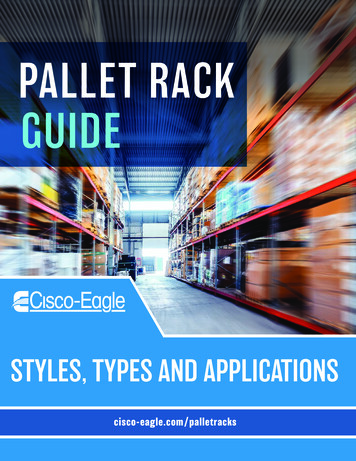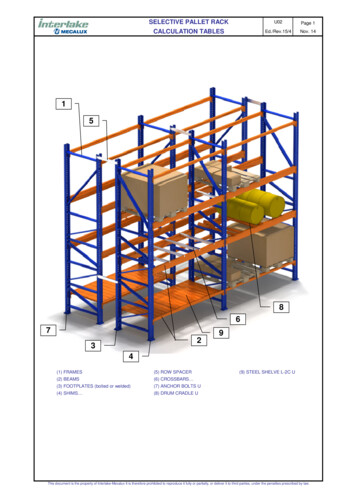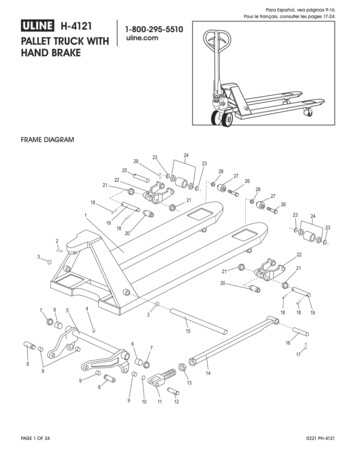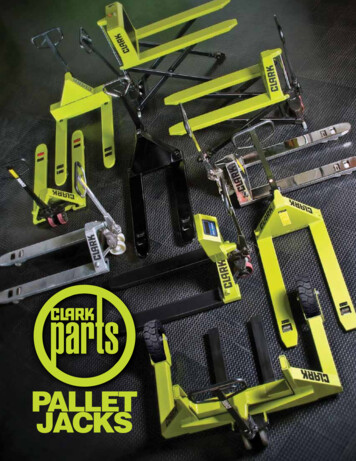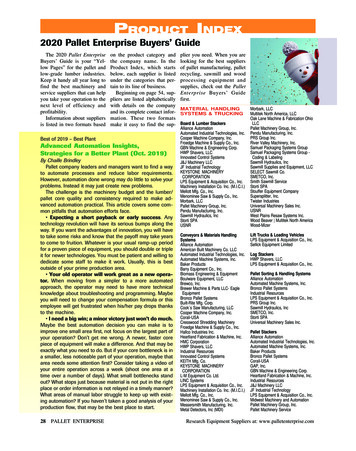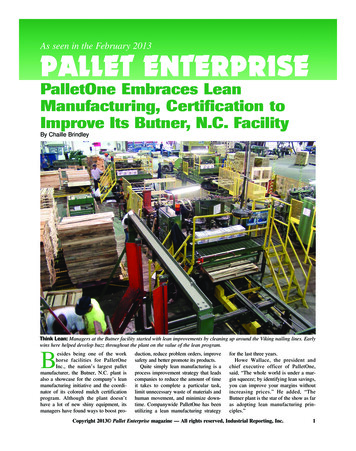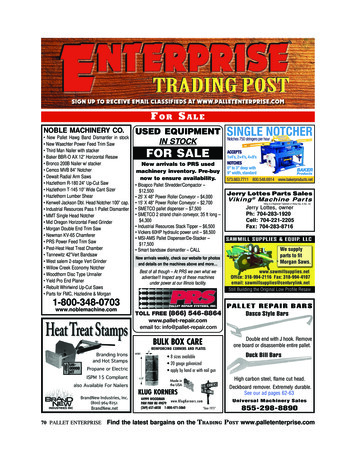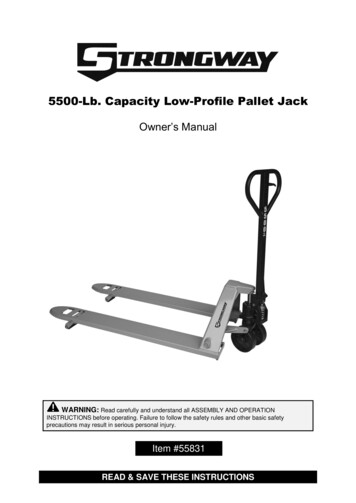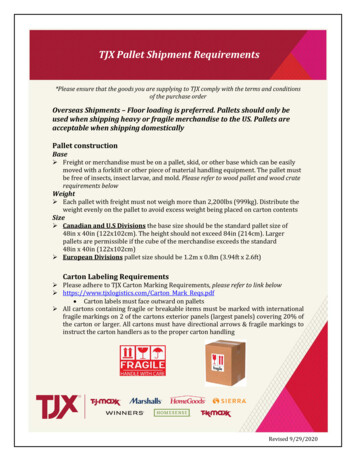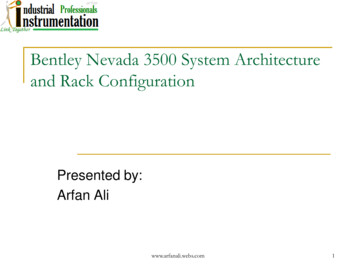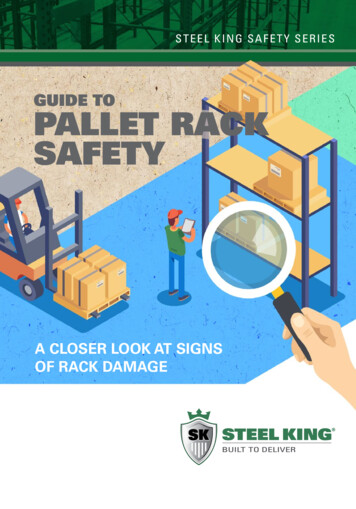
Transcription
STEEL KING SAFETY SERIESGUIDE TOPALLET RACKSAFETYA CLOSER LOOK AT SIGNSOF RACK DAMAGE
Rack SafetyPallet rack can be a great asset to your company, helpingyou make the most of your storage space and optimize theorganization of your products.However, when rack is damaged or incorrectly loaded or installed, it can become dangerous.Periodic visual inspections will not only help you comply with safety regulations and work moresafely, it will help you spot poor practices in your operation that might otherwise go unnoticed.Even the best-built pallet rack can sustain damage. When racks are overloaded or aredamaged, it can compromise a rack’s capacity and put your system at risk. Let’s face it, driversare not likely to report collisions, so you may not know in a timely manner if a rack has beencompromised.It’s well worth your time to schedule regular inspections. The sooner you know about adamaged upright, the sooner you can replace or repair it. Don’t wait for an inspector to tellyou. New uprights are relatively inexpensive; a rackcollapse is not.The RMI (Rack Institute of America) has manyresources for rack users:www.mhi.org www.rmiracksafety.orgANSI MH16.1:2012; Specification for the Design, Testing andUtilization of Industrial Steel Storage RacksRMI Considerations for the Planning and Use of Industrial SteelStorage Racks 3-21-2018RMI Guideline for the Assessment and Repair or Replacement ofDamaged RackRMI Safety Blog Pallet Beam Deflection: How Much is Acceptable? Dated April 30, 2018Source: RMI Considerations for the Planning and Use of IndustrialSteel Storage Racks 03-21-20182
WWW.STEELKING.COMWhen is beam deflection a problem?Manufacturer’s beam tables are generally based on uniformly distributed loads. Both the capacity andthe beam deflection will vary if the load is not uniformly distributed on the load shelf beams. While somedegree of deflection is normal for a loaded rack system, how can you tell when the amount of deflectionindicates a reduction in beam capacity?Helpful Hint:OVERLOADED BEAMSDEFLECTIONGAPReference StandardExample:LENGTH OF BEAM18096” BEAM180 ALLOWABLE DEFLECTION .52” ALLOWABLE DEFLECTIONAny beam with visibledeformation or cracking ofthe beam end connectorsor welds should beunloaded and replaced.Be sure beams are fullyengaged when installedand the safety locks areproperly seated.How to determineif beams are overloadedHelpful Hint:!Any beam with visible deformation or cracking of the beam endconnectors should be unloaded and replaced. Be sure beamsare fully engaged and installed with proper safety lock.1. Observe the beam deflectionThe maximum allowed deflection is beam length divided by 180. Deflection greater than this is anoverloaded beam. Max deflection is located at beam midpoint for a uniformly distributed load.*Certain AS/RS or automated systems typically specify a tighter deflection limit for load beams,such as the length of the beams divided by 240 (or 0.42%). This tighter deflection requirementminimizes the risk of the automation (or the load) coming into contact with the beams duringplacement or removal.Is there permanent deflection when beam is unloaded? If “yes,” the beam has beenoverloaded and needs to be replaced.2. Check the connection at the frameInspect the area where the beam connects to the frame. If any ofthe following conditions are present, the beam should be replaced. There is any visual deformation of the column and/or clip indicatingthat the beam was either damaged by impact or overload There are any cracks in welded joints The safety clip cannot be properly connected and fully engaged.3
Rack damage and capacityA damaged beam or frame will reduce the rack capacity.Damaged components should be replaced, according to theRMI guideline for the assessment and repair or replacement ofdamaged rack.Steel King strongly recommends replacing any damaged rackcomponents.About rack capacitiesIt is crucial to check that your rack is not carrying more load thanit’s designed for.Beam Capacity RequirementCalculating the required capacity of a pallet rack beam is fairlystraight forward. Start with the heaviest possible load you’d bestoring in a given pallet position. For example – 2,500#.Considering the manyvariables that affect rackcapacity, it is alwaysadvisable to have a materialhandling professionalconfirm your capacitycalculations.Multiply this number by the number of pallet positions per beamlevel. If the number of pallet positions per beam level is two, yourrequired beam capacity would be at least 5,000#What Factors Affect System Capacity?To determine the approximate frame capacity, you will need tomeasure the maximum vertical beam spacing that is being used.The beam spacing is found by measuring from the top of onebeam level to the top the next beam level, so it includes the heightof the beam plus the space between the beams.To get a precise calculation, you will also need to account for therack upright height, width, gauge, pattern, and foot plate size, aswell as beam properties – length, width, gauge, beam connector.Load distribution along your beam will also affect capacity.There are a number of other factors that affect pallet rackcapacity – from your seismic zone to you floor properties(thickness, strength), and soil all impact your capacity.Capacity PlaquesCapacities for each bay type should be stated on load capacityplaques in one or more conspicuous locations.NSI MH16.1:2012; Clause 1.4.24
WWW.STEELKING.COMRack Inspections: Where to Start?While the following checklist does not replace a formal rack inspection, it is a goodway to spot potential problem areas.Rack EnvironmentIs lighting adequate?Are aisles clear of clutter?Is rack protection in place?Installing adequate lighting in your facility is an easy way tohelp forklift operators see rack uprights and other obstaclesthat may be in their path.Keeping traffic areas free of obstacles allows your vehicleoperators to take the safest path, maintaining a safe distancebetween forklifts and rack structures.Rack protectors are relatively inexpensive and can significantlyextend the life and safety of your rack. These can take the formof guard rails, aisle-end guarding, or column protectors thatstrengthen rack uprights or deflect impact at high risk areas.Rack ConditionAre the racks plumb andlevel?Collisions by a forklift may have a greater impact on racksthat aren’t set level. And an uneven surface can affect loaddistribution. This can occur with rack that has been reconfiguredor where the foundation may have settled. Rack should beshimmed and plumbed appropriately.Are components rusted orcorroded?This may indicate a couple of potential issues. If paint appearsscraped, a rack may have suffered a collision. If rust has formed oris allowed to progress, it may weaken the capacity of your system.Is the rack overloaded?Along with dislodged beam and forklift damage, overloading is theother primary cause rack failure. This can happen inadvertentlywhen changes are made to the rack load or profile withoutchecking capacities. Remember that beams have a ratedcapacity per pair when equally loaded, and that uprights dependto a great degree on beam spacing for their capacity ratings.Are rack load ratings posted? Rack capacity may be hard to assess if load ratings are notposted. OSHA recommends that load ratings be present whichprovide the maximum permissible unit load and/or maximumuniformly distributed load per level, the average unit load, andmaximum total load per bay. See ANSI/RMI MH16.1.5
UprightsAre they bent or damaged?Check the horizontal braces for any bending, twisting, or brokenwelds. Are there paint scrapes that might indicate an impact?Even minor damage can reduce the upright capacity. Replace orrepair these uprights immediately.To check the degree of damage, measure the gap by placing astraight edge along the surface of the concave side of a damagedrack upright. Center the straight edge on the damaged section’slength as completely as possible. Measure the gap between theupright and the straight edge. If the damage that produces anoverall bend in the upright (not just a dent) of more than a fewmillimeters, this may be cause to replace or repair it.Check your foot plates.Are they properly lagged to the floor? Are shim stacks nestedsquarely under the foot plates?Are column protectorsinstalled?Most often, the best way to address rack damage is to preventit. Well-placed guard rails and aisle-end protection can preventa great deal of damage to your system and ensure the safety ofyour equipment and your workers. If you have column protectorsand notice damage, further inspection is warranted. Often, theseitems are painted safety yellow for greater visibility.Check bracing.Are any braces missing. Check thoroughly for any bending orother damage.Assembly6Correct componentsCheck for incompatible or incorrectly assembled components orimproper repairsAre any componentsmissing, damaged orimproperly alignedCheck to make sure there are no components that are missing orimproperly aligned or nested. Are any components loose?Safety equipment; loadrestraintAre there pallet stops or safety netting adjacent to service aisles?Is there overhead guarding at tunnel bays?This includes baseplates, shims, spacers, safety clips and pins,anchors, bolts, and safety bars.
WWW.STEELKING.COMBeamsAre the beams properlyattached to the uprights?Are the beams seated tightly into uprights? Has there beenimpact to the area? Are there broken welds or other signs ofdamage? Are safety clips still tight; are bolts still tight?Inspect beam surfaceAre there any dents, distortion, or evidence of an impact? Be sureto check the beam face and flanges.Are the clips, bolts, or safety Most racks use some kind of connector hardware aside from thepins, or beam attachmentteardrop or keyhole to ensure tight fit and safety. Some evenpins missing or damaged?utilize more than one method. Inspect yours to make sure theyare all securely fastened and undamaged.Check for deflectionBeams naturally deflect beneath a load, and a certain amount ofdeflection is acceptable, but it should disappear when you unloadthe beams. If it doesn’t, the beams need to be replaced, as theyhave been deformed by overloading or impacts. Beams shouldn’tbow more than 1/180th of the total length of the beam (for a 96”beam, that’s half an inch).UsageClearancePalletsCheck for any overhanging, double-stacked, or damaged pallets.Are all pallets the correct size for the rack?Safety equipment; loadrestraintAre there pallet stops or safety netting adjacent to service aisles?Is there overhead guarding at tunnel bays?High Risk AreasSome storage areas are inherently more prone torack damage. These should be inspected more frequently and more thoroughly:Aisle Width. The narrower the aisles, the more likely material handling equipment is to impact the rack.Transfer Aisles. Rack rows with transfer aisles aremore prone to damage.Product Value. Did you know that the less expensive the product stored in an area, the more likely therack is to be damaged? Damages can add up. These Previous Damage. Areas that have been damagedareas need additional protection.in the past are more likely to be damaged again.7
Frequently Asked QuestionsHow frequently do racksneed to be inspected?The answer to those questions is highly situation dependent.Recognizing that every storage rack application and operationis different, RMI’s publication Considerations for the Planningand Use of Industrial Steel Storage Racks recommends onlythat the system owner establish and implement a program ofregularly scheduled inspections, offering guidelines to determinefrequency. Additionally, the guidelines advise that a system shouldbe inspected immediately after any event increases the likelihoodof damage to the rack – such as a forklift collision or a seismicevent.At a minimum, inspections should be performed annually. A bestpractice rule of thumb, however, is that inspection frequencyshould correspond to the higher the velocity of inventorythroughput, traffic or activity in the racking.What type of training orqualifications should aninspector have?Internally performed inspections should be conducted bya qualified team member who is familiar with the storagerack’s design and installation requirements. The first step inthe inspection is to ensure that the rack configuration andcomponents match the original design documentation. Once thathas been confirmed, damage assessments can be conducted.Additionally, it can be advantageous to engage an independentinspection professional. Team members who routinely workaround a rack structure may overlook subtle signs of damageor unapproved changes to the configuration. Hiring an outsideinspection service to perform an in-depth review and detailedmeasurements helps to ensure an unbiased evaluation.Regardless of who performs the rack safety inspection, theschedule and results should be documented and retained on fileeach time for future reference.8
WWW.STEELKING.COMWhen is it okay to repair arack instead of replace it?For systems with the original design documentation that havenot been modified or reconfigured, damaged components cannormally be replaced with identical new components from the samemanufacturer.The same does not hold true for undocumented or reconfiguredsystems. For that reason, rack owners and facility managers shouldnot attempt to undertake a rack repair without first engaging theservices of a qualified, professional engineer to supervise anddirect the assessment of the system’s condition, as well as designand oversee the ultimate repair or replacement.Beyond the Walk-ThroughWhile a visual review is not a thorough inspection, it’s a valuablefirst alert!Be sure to document and take action when needed. Documentationhelps you track the regularity and thoroughness of the inspectionprocess.These tips provided here are for informational purposes; see arack inspection professional for a thorough ra
ANSI MH16.1:2012; Specification for the Design, Testing and Utilization of Industrial Steel Storage Racks RMI Considerations for the Planning and Use of Industrial Steel Storage Racks 3-21-2018 RMI Guideline for the Assessment and Repair or Replacement of Damaged Rack RMI Safety Blog Pallet Beam Deflection: How Much is Accept-able? Dated April 30, 2018
